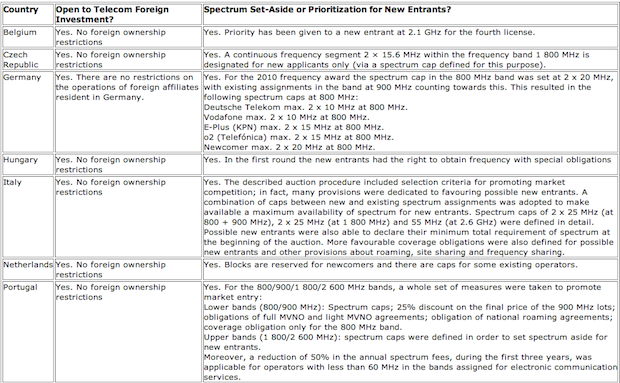
Ottawa’s Plan for Foreign Wireless Competition Looks Normal Compared to Other Countries [Chart]
Since the Verizon bombshell hit the Canadian wireless market, the incumbents have been using every possible method to pressure Ottawa into reversing its wireless policy of set-aside spectrum. The reason behind this is pretty straightforward: to keep foreign investment out of Canada and create a closed market, one which is already controlled by them. Ottawa, on the other hand, wants to open up the wireless market to foreign investors. But does the government’s policy differ from those of other developed economies? Michael Geist tried to find out.

The incumbents have nicely orchestrated a media campaign that may lead some of us to think: man, the government’s policy differs widely from other countries, and they are heading down on the wrong path.
Indeed, from the perspective of a player (or players) that controls 85% of the wireless market, Ottawa is getting it wrong: the government wants to open the door to foreign telecom investment after having kept the market closed for many years, and yes, it has set aside spectrum for new entrants so they can kick start competitive wireless services in Canada.
But is this policy uncommon?
After looking at the 2013 OECD Communications Outlook report, the answer is obvious: the twin policy of allowing foreign investment and set-asides to facilitate competition is a very common practice in developed countries. Michael Geist points to a few of the many examples of the above policy.
What may sound a bit uncommon is the fact that Canada appears to have been a bit late opening its telecom market, so the country is now doing both at the same time.
So what is the situation in other countries? The Belgian telecoms market is open to foreign investment, and indeed the government has even given priority to a new entrant at 2.1 GHz for the fourth license. Something similar is happening in Germany as well: there are no restrictions on foreign investment, and the spectrum set-aside policy has resulted in the following spectrum caps at 800 MHz:
-
Deutsche Telekom max. 2 x 10 MHz at 800 MHz.
-
Vodafone max. 2 x 10 MHz at 800 MHz.
-
E-Plus (KPN) max. 2 x 15 MHz at 800 MHz.
-
o2 (Telefónica) max. 2 x 15 MHz at 800 MHz.
-
Newcomer max. 2 x 20 MHz at 800 MHz.
What is particularly interesting in our case — because it’s very similar to what is now happening in Canada — is the UK example:
In its July 2012 statement setting out the 4G auction process of 800 Mhz and 2.6 Ghz spectrum bands, Ofcom noted in its conclusion that UK consumers are likely to benefit from better services at lower prices if there are at least four credible national wholesalers of 4G mobile services. Therefore, in the interests of competition, Ofcom decided to reserve a minimum amount of spectrum in the auction for a fourth operator. This could be either the UK’s current fourth MNO, Three (Hutchison 3G), or a new entrant altogether. Ofcom also considered it appropriate and proportionate to impose limits on the amounts of spectrum that each bidder can acquire in the auction, such that their overall holdings of “mobile spectrum” in general, and sub-1 GHz “mobile spectrum” in particular, do not exceed certain safeguard caps. This is in order to mitigate the risk of highly asymmetric spectrum holdings after the auction leading to lower competitive intensity.

In the UK, Ofcom, the communications regulator, has decided that consumers will likely benefit from competitive prices if there are at least four national players. So, to maintain competition, it has put aside a minimum amount of spectrum in the auction for a fourth operator. This has happened in the wake of lawsuit threats, etc., similar to those we are now seeing in Canada.
We can only hope that Industry Canada will maintain its position and won’t let the big three control the whole of the wireless market.

